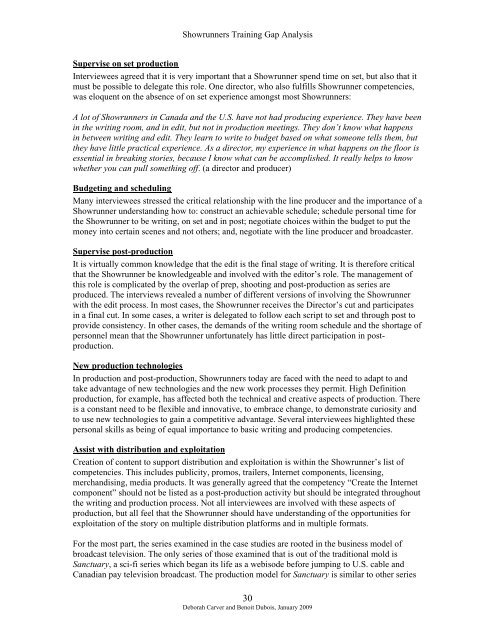Showrunners - Training Gaps Analysis - Cultural Human Resources ...
Showrunners - Training Gaps Analysis - Cultural Human Resources ...
Showrunners - Training Gaps Analysis - Cultural Human Resources ...
You also want an ePaper? Increase the reach of your titles
YUMPU automatically turns print PDFs into web optimized ePapers that Google loves.
<strong>Showrunners</strong> <strong>Training</strong> Gap <strong>Analysis</strong><br />
Supervise on set production<br />
Interviewees agreed that it is very important that a Showrunner spend time on set, but also that it<br />
must be possible to delegate this role. One director, who also fulfills Showrunner competencies,<br />
was eloquent on the absence of on set experience amongst most <strong>Showrunners</strong>:<br />
A lot of <strong>Showrunners</strong> in Canada and the U.S. have not had producing experience. They have been<br />
in the writing room, and in edit, but not in production meetings. They don’t know what happens<br />
in between writing and edit. They learn to write to budget based on what someone tells them, but<br />
they have little practical experience. As a director, my experience in what happens on the floor is<br />
essential in breaking stories, because I know what can be accomplished. It really helps to know<br />
whether you can pull something off. (a director and producer)<br />
Budgeting and scheduling<br />
Many interviewees stressed the critical relationship with the line producer and the importance of a<br />
Showrunner understanding how to: construct an achievable schedule; schedule personal time for<br />
the Showrunner to be writing, on set and in post; negotiate choices within the budget to put the<br />
money into certain scenes and not others; and, negotiate with the line producer and broadcaster.<br />
Supervise post-production<br />
It is virtually common knowledge that the edit is the final stage of writing. It is therefore critical<br />
that the Showrunner be knowledgeable and involved with the editor’s role. The management of<br />
this role is complicated by the overlap of prep, shooting and post-production as series are<br />
produced. The interviews revealed a number of different versions of involving the Showrunner<br />
with the edit process. In most cases, the Showrunner receives the Director’s cut and participates<br />
in a final cut. In some cases, a writer is delegated to follow each script to set and through post to<br />
provide consistency. In other cases, the demands of the writing room schedule and the shortage of<br />
personnel mean that the Showrunner unfortunately has little direct participation in postproduction.<br />
New production technologies<br />
In production and post-production, <strong>Showrunners</strong> today are faced with the need to adapt to and<br />
take advantage of new technologies and the new work processes they permit. High Definition<br />
production, for example, has affected both the technical and creative aspects of production. There<br />
is a constant need to be flexible and innovative, to embrace change, to demonstrate curiosity and<br />
to use new technologies to gain a competitive advantage. Several interviewees highlighted these<br />
personal skills as being of equal importance to basic writing and producing competencies.<br />
Assist with distribution and exploitation<br />
Creation of content to support distribution and exploitation is within the Showrunner’s list of<br />
competencies. This includes publicity, promos, trailers, Internet components, licensing,<br />
merchandising, media products. It was generally agreed that the competency “Create the Internet<br />
component” should not be listed as a post-production activity but should be integrated throughout<br />
the writing and production process. Not all interviewees are involved with these aspects of<br />
production, but all feel that the Showrunner should have understanding of the opportunities for<br />
exploitation of the story on multiple distribution platforms and in multiple formats.<br />
For the most part, the series examined in the case studies are rooted in the business model of<br />
broadcast television. The only series of those examined that is out of the traditional mold is<br />
Sanctuary, a sci-fi series which began its life as a webisode before jumping to U.S. cable and<br />
Canadian pay television broadcast. The production model for Sanctuary is similar to other series<br />
30<br />
Deborah Carver and Benoit Dubois, January 2009










